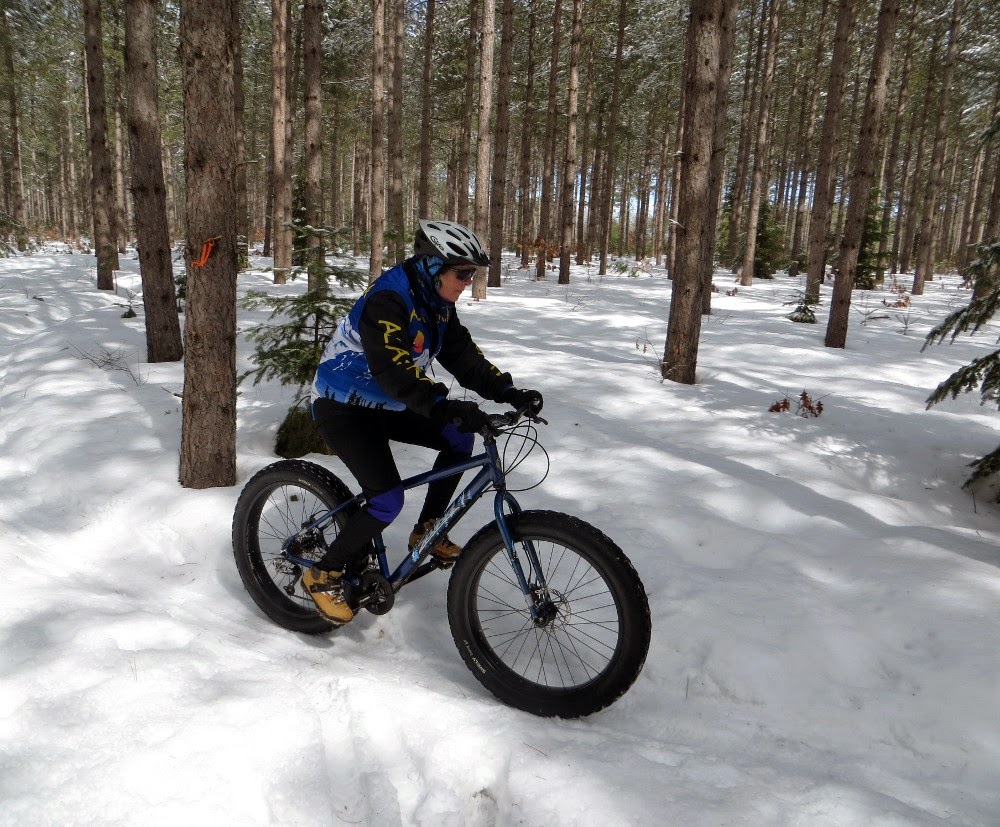Thirty years after the first Iditabike was held in Alaska (in 1987), the use and popularity of fat bikes (aka snow bikes) has gone mainstream with major bicycle manufacturers, like Specialized and Trek, producing fat bike models. Thirty years ago, the modern fat bike, as we know it today, did not yet exist but the idea of making wider rims that could give mountain bike tires a wider footprint and thus better floatation on snow was introduced by Fairbanks, Alaska resident, Simon Rakower, in conjunction with the Iditabike, the first winter mountain bike race on a part of the famous Iditarod Trail. By 1991, the Iditabike (along with the Iditaski) had evolved into the Iditasport, an event that could be done on bikes, skis or on foot.
In March 2014, the Fat Bike Birkie was named the Fat Bike National Championships just one year after the inaugural year of the race on the Birkie Trail. The winter of 2013-2014 saw an explosion of fat bike riders in the Hayward area, with a fat bike club formed, some local singletrack trails groomed for the first time for fat bikes, and the two local bike shops offering a selection of fat bike brands and models.
I bought a fat bike last March, a used Salsa Mukluk, and rode it off and on during my "30 Days of Biking" last spring, which came in very handy because of all the snow we had in April. Mike has had a Pugsley for years (probably the first production fat bike frame), but sold it last year and bought a frame from 9:ZERO:7, a company based in Anchorage, Alaska.
We went out on our fat bikes for the first time this winter at the end of December, on one of the few bluebird days we had all month. On that first ride, we didn't venture out on any trails but stuck to some quiet, snow-covered back roads. A couple of days after New Year's, we took our fat bikes to the Seeley Hills and rode on the singletrack trails there.
The trail was hard packed by previous fat bikers but the packed section was fairly narrow at times, making steering a bit tricky. If one got off the packed section, it was easy to bog down.
The trail also had some longish uphill sections that we ended up walking due to the steepness and our rear wheel losing traction. Eventually, the singletrack dumped us out on the wider, ski trail where we decided to turn around and head back to the trailhead the way we had come.
Afterward, we headed to the Hospital Trails to see if the snowshoe trails were rideable. Although no fat bike tracks were visible, the snowshoe trails were hard packed and very rideable; the flat terrain makes them fairly easy to ride, although the narrow, twisty path through the forest makes for some quick and challenging steering at times.
 |
| Trying my Salsa Mukluk fat bike for the first time last spring. |
A brief timeline of the Iditabike/Iditasport:
1973 First Iditarod Trail sled dog race, 1000 miles to Nome.
1987 Iditaski and Iditabike are held on separate weekends.
1991 First Iditasport. 100 miles up the Iditarod Trail on bikes, skis and foot.
1997 First Iditasport Extreme - 350 miles over the Alaska Range to McGrath
2000 First 1000 mile edition of Iditasport to Nome
2002 First Iditarod Trail Invitational (replaces Iditasport)
2014 Iditasport returns after last edition in 2001.
Links detailing the race history and some first-hand accounts of the early Iditabike/Iditasport events:
Race history: http://www.iditarodtrailinvitational.com/race_history.php
Jill Homer's Iditabike history:
http://halfpastdone.com/2013/02/20/a-brief-history-of-iditabike/
Account of first, 1987, Iditabike:
http://sonic.net/~ckelly/Seekay/iditabike.htm
Account of 1990 Iditabike:
http://sonic.net/~ckelly/Seekay/1990_iditabike.htm
A brief history of Fat bikes:
http://www.adventurecycling.org/resources/blog/a-brief-history-of-fatbikes/






No comments:
Post a Comment